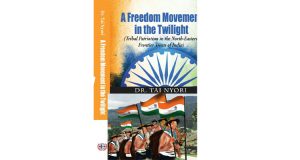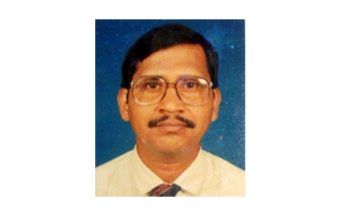 By Professor M. C. Behera, AITS
By Professor M. C. Behera, AITS
The book under review is entitled The Freedom Movement in the Twilight: Tribal Patriotism in the North-Eastern Frontier Tracts of India. It is authored by Dr. Tai Nyori and published by Nation Press, 4831/24, Govind Lane, Ansari Road, Daryaganj, New Delhi-110002. It is priced at Rs. 995. The book is about the freedom movement in Arunachal Pradesh, unknown in academics that continued even after the Independence of India. It reveals many unknown facts, particularly tribal contribution at micro level to the freedom movement of the country.
The present Arunachal Pradesh, which passed through two politico-administrative stages, namely North-Eastern Frontier Tracts (1914 to 1954) and North-Eastern Frontier Agency (1954-1972), was known as terra incognita (unknown or hidden land) during first part of 20th century. When, who and why the designation of unknown land was assigned are not clearly known. But some scholars reason out Innerline Regulation of 1873 that separated hills people from those of plains. The hills people were kept ‘behind iron curtain’. But two phrases, ‘unknown land’ and land ‘behind iron curtain’ connote two different meanings; ‘behind the iron curtain’ does not mean ‘unknown’.
Prior to 1914, for the British, the people and the land (hills) were subject of survey. However, what was the status of the hills in the then geo-political map needs further study which is beyond this review article.
Were the people and the territory now known as Arunachal Pradesh unknown outside? The question raises another question. What is the scope of the construct ‘outside’? Does it mean territory adjacent to or very far off?
There are historical records that link the people of the land with the Ahoms before the British. Even during the reign of Pratap Singha (1603-41) posa was granted to the Nyishis and the Akas; the katakis were appointed to keep watch on the movement of the Nyishis. The conciliation measure through posa implies that the Nyishis and the plains people of Assam had some sort of interaction. The nature of interaction was not one dimensional. This is evident in Ahom Burajis.
The relation with the territory also goes beyond Ahom period. Kalika Puran and Yogin Tantra which were composed in Assam or in its neighbourhood during 6th-8th centuries have mentioned about Parshuramkund and pilgrimage. The copper plate inscription of Indrapala, the king of Kamrupa (1045-1065), states that his father had matrimonial alliances with the royal family reigning over the extensive territory reclaimed by the arms of Parshuram. The trade relations of the tribes of present Arunachal Pradesh, through communities inhabiting border land, with Tibet do not subscribe to the idea that the people were unknown outside their inhabited territory.
Arguably, the designation terra incognita is a misnomer; reflecting colonial ignorance about people and territory. This phrase was also popular among Indian scholars for a long time. When Arunachal Pradesh as terra incognita was making round a strong movement for achieving freedom from the colonial rule by a section of people of this territory was at its zenith. This movement, very crucial in the history of freedom movement of India, unfortunately did not get a place at national or regional history till date. The movement with the support of Congress leaders of Assam, including Lokapriya Gopinath Bordoloi, was so crucial that it spoilt the British policy of establishing a Crown colony in the hills bordering Assam and Myanmar. This movement also justifies, unfortunately, the designation of terra incognita in the context of the then national leaders who were ignorant about the fact that the British ruled NEFT at least for 8 months after India became independent. This is the core theme of the book entitled The Freedom Movement in the Twilight: Tribal Patriotism in the North-Eastern Frontier Tracts of India which is authored by Dr.Tai Nyori. Dr. Nyori is known as an academic administrator in the state. But his book entitled History and Culture of the Adis, published in 1993 has brought him international acclaim. Foreign scholars working on Tibet, Lobo community or on Adis cite the work as original source.
The book, i.e. The Freedom Movement in the Twilight: Tribal Patriotism in the North-Eastern Frontier Tracts of India which is under review, has five chapters and an introduction. The chapters are: 1. The Abors and the English, 2. Causes of the Movement, 3. Events of the Movement, 4. Achieving Freedom: British Administration Replaced by Indians, and 5. Conclusion: Nature of the Movement. The book critically examines Abor (the author uses this designation, used in colonial literature, to denote present Adis and Galos) relations with the British, and contributing factors and courses of the freedom movement through its different chapters. It concludes by analysing the nature of the movement within the frame of freedom movement of India.
At this point, it is crucial to note that history of tribal fights against the British for a long period have been echoing the voice of colonial writers and records. The fights have been attributed to the one or the other tribe, as can be argued, deliberately silencing its grand social matrix of the region. Obviously, the ‘policy of divide and rule’ underlies in naming tribal revolts so that social segregation gets reinforced and Indian communities do not stand united. It is very much evident in the present work of Dr.Nyori which is equivocally critical of British policy to divide the then Abor communities through the policy of Administered and Un-administered Areas.
In addition, Dr.Nyori’s work is a seminal contribution on three counts. First, the movement drove the British from the North-Eastern Frontier Tracts. With this the dream of the Crown colony consisting of the hills of the then Assam and Burma according to Robert Reid’s plan got shattered. Peter Loren Seton James, the Political Officer at Pasighat had already organised a pro-British group who not only supported him to realise his dream to continue colonial rule and establish Crown colony, but also objected to the freedom movement under the leadership of Moji Riba, Moje Riba and others. James was instrumental in mobilising the Political Officers in the territory and a section of people to realise Reid’s plan. After his removal in response to and as an outcome of the movement the plan failed.
Second, it points to the ignorance of the national leaders who were not aware of continuity of the British administration after Independence of the country.
Third, the leaders of the movement wanted the territory to become a part of Indian Union, but not with the Crown colony. The Freedom Movement that extended after Independence helped in annexation of the territory, the North-Eastern Frontier Tracts (present Arunachal Pradesh) to independent India. It should be mentioned that the annexation of region with Indian Union was not the efforts of leaders like Sardar Ballabhbhai Patel, Dr. Hare Krushna Mahatab and others, but of the people of the region themselves. The great patriotism of these people is yet unknown to Indian masses and the present book is a pioneering work to tell the saga of tribal patriotism, and the tribal people’s contribution in making the history of freedom movement of India. Perception of India as a Nation State will have its full meaning when these small peripheral contributions are understood in terms of their indispensability at the time when they were made. The movement contributes a crucial chapter in the composite history of Freedom Movement of India.
The book is a must-read for all those interested to know the composite history of freedom movement of India and place of tribes in it. The book is an addition to methodological innovation: how to reconstruct history from below generally consisting of people like tribes without written tradition and records.



